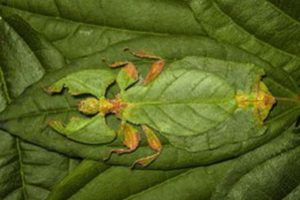Context:
An international research team recently described seven previously unknown species of leaf insects, also known as walking leaves.

Relevance:
Facts for Prelims
Walking Leaves: Nature’s Leaf Impersonators
- Walking Leaves, also known as leaf insects, are insects that closely resemble leaves in appearance.
Diverse Species :
- More than 50 species of these flat, typically green insects belong to the order Phasmida or Phasmatodea.
- They are renowned for their striking leaf-like mimicry.
Diet and Habitat
- Walking Leaves primarily feed on plants and prefer densely vegetated areas.
Distribution
- Their natural habitat spans from Indian Ocean islands through parts of mainland South Asia and Southeast Asia to Papua New Guinea and Australia in the western Pacific.
Distinctive Features
- Size: Typically measure between 28 to 100 mm (1.1 to 3.9 inches) in body length.
- Sexual Dimorphism: Females are generally larger than males.
- Varied Coloration: They are predominantly brown or green, with some exhibiting slight speckles or serrated leaf-like edges.
Mimicking Leaf Motion
- Movement: These insects sway and rock, mimicking the motion of leaves swaying in the breeze.
Flight Capability
- Female walking leaves lack the ability to fly.
- Males possess well-developed hind wings, enabling them to fly short distances.
Regenerative Limbs
- Remarkably, the arms and legs of walking leaves have regenerative capabilities.
Reproductive Process
- Reproduction occurs sexually, with females laying eggs that often resemble seeds or plant structures, further enhancing their camouflage.




